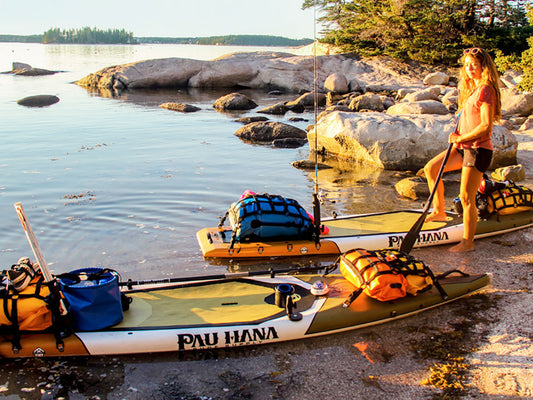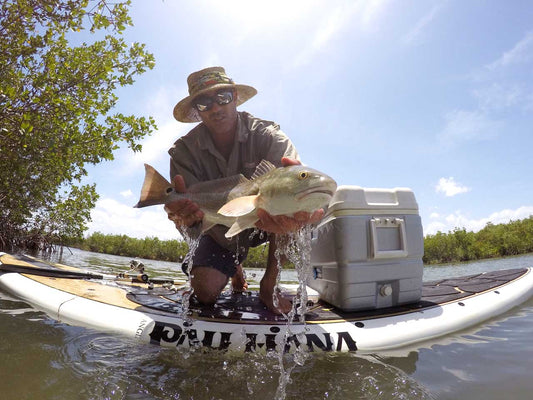Your paddle might not get as much attention as your board, but don’t let that fool you - it’s doing a lot of the heavy lifting. The right paddle keeps your shoulders happy, your strokes smooth, and your stoke levels extra high. The wrong one… well, you’ll feel it halfway through your session.
Let’s break down everything you need to know, so you can pick a paddle that feels like an extension of you and not a chore to swing around.
2. The Parts of a SUP Paddle
Every paddle has three main components, and each one plays its part in your performance:
- Blade: The blade is the wide portion that grabs the water. Its size and shape determine how much power each stroke delivers.
- Shaft: The shaft is the long centre section. This is where weight, stiffness, and length can make a huge difference.
- Handle / Grip: The top piece your palm connects with and your fingers wrap around - and yes, the shape matters more than you'd think.
Understanding these basics makes choosing the right setup a lot easier.
3. Paddle Materials: Where Weight, Durability & Price Meet
Materials can make or break your experience. Here’s the quick rundown:
Aluminium
Aluminium is a budget-friendly, ultra-durable option - great for beginners, family use or rental fleets. But it’s heavier, which means paddling longer distances can feel like a workout you didn’t sign up for.
Fibreglass
Fibreglass is a sweet middle ground. Lighter than aluminium, stiffer, and easier on the shoulders. Fibreglass is a favourite for intermediate paddlers who want that extra efficiency without the price tag of a carbon paddle.
Carbon Fibre
Carbon Fibre is the dream material. It’s feather-light, super stiff, and powerful. If you're touring, racing, or paddling long days, a carbon SUP paddle will help you go farther with less effort and less fatigue.
Plastic / Nylon Blades
Plastic and nylon blades are often paired with aluminium or fibreglass shafts. They are highly durable and affordable, though not as efficient as carbon or fibreglass blades making them great for beginners, kids, or rental use.
4. Blade Size & Shape: How You Put Power Into the Water
Your blade decides how “heavy” each stroke feels.
Blade Size
- Large blades = More power per stroke but require more strength. Large blades are great for strong paddlers or short, powerful bursts.
- Smaller blades = Easier on the body and better for endurance, beginners or smaller paddlers.
Blade Shape
- Teardrop: Teardrop shapes have more surface area at the bottom which means they grab lots of water right away, from the moment they enter the water. The teardrop shape makes them great for powerful strokes.
- Rectangular: Rectangular blade shapes evenly distribute the effort throughout the stroke, making them ideal for cruising and long-distance sessions.
Blade Angle
Most blades sit at a 10-12° angle. Bigger angles push water more efficiently while smaller angles are more responsive, making smaller blades good for surfers who need quick direction changes.
5. Paddle Length: Your Goldilocks Zone
Here’s a simple rule that works for most people:
Choose a paddle 8-12 inches taller than you.
But consider your style:
- Flatwater / Touring: Slightly longer paddles can offer smoother, more efficient strokes.
- SUP Surfing: Choose a shorter SUP paddle for quick manoeuvrability.
- Sharing your paddle? An adjustable paddle is the way to go.
Adjustable vs. Fixed
- Adjustable: Flexible, shareable, great for beginners, however they are slightly heavier.
- Fixed: Lightest, most performance-driven option that’s perfect when you know your preferred length.
6. Shaft Flex: Comfort vs. Power
- Stiff shafts: Stiff shafts have better energy transfer, ideal for racing or long-distance touring.
- Flexible shafts: Soften the impact and reduce joint strain in choppy conditions. Great for casual or recreational paddlers.
It’s all about your comfort level and how long you’re out on the water.
7. Handle Shape: A Small Detail with a Big Impact
Two main types:
- T-Grip: Precise control (racers love it).
- Palm Grip: Softer, more comfortable, great for cruising or long sessions.
Try both if you can and let your hands will tell you which one they prefer.
8. Match Your Paddle to Your Paddling Style
Recreational Paddling
Look for an adjustable fibreglass or aluminium paddle with a mid-sized blade.
SUP Surfing
Look for a shorter paddle, small-to-medium blade and comfortable grip. Agility is key.
Racing & Touring
Look for a lightweight option like Carbon fibre. You’ll want a stiff shaft, larger blade and fixed length for maximum efficiency.
9. Final Thoughts: Choose What Keeps You Smiling on the Water
Your paddle should help you last longer, glide better, and enjoy every after-work escape or sunrise paddle. If you can, demo a few options. Pay attention to how your shoulders and back feel - your body always gives honest feedback.
A well-chosen paddle is one of the best upgrades you can make. It’s not just a piece of equipment, it’s the tool that makes every adventure feel effortless.





